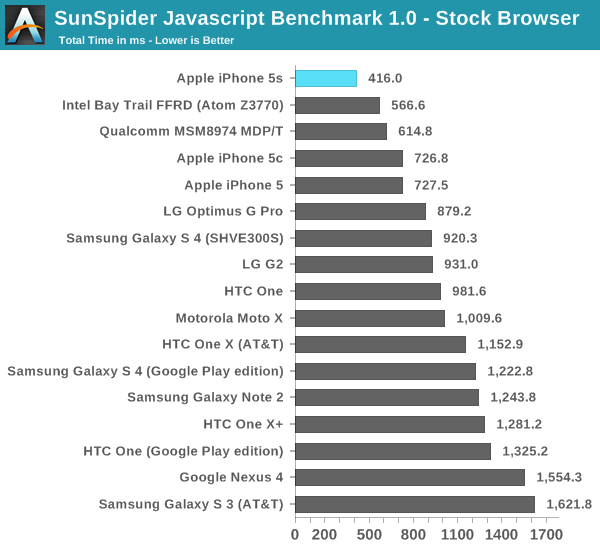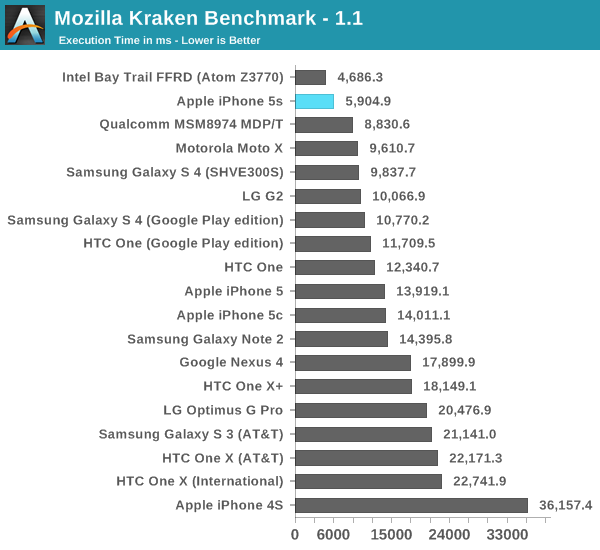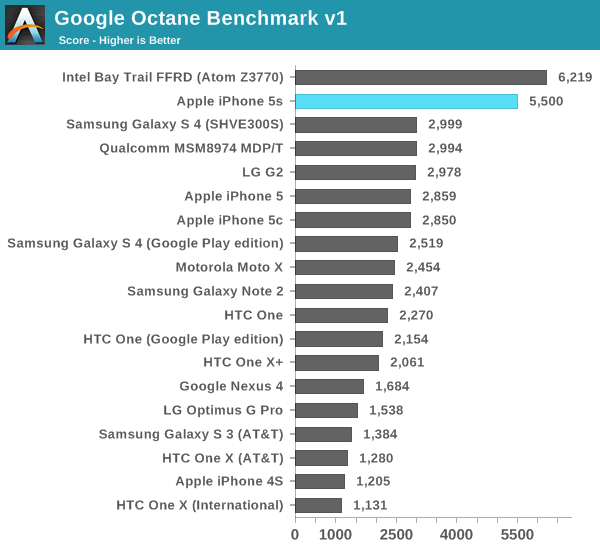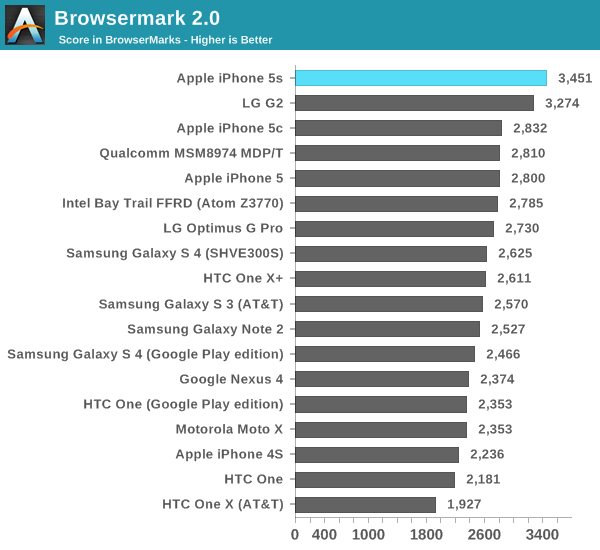The iPhone 5s Review
by Anand Lal Shimpi on September 17, 2013 9:01 PM EST- Posted in
- Smartphones
- Apple
- Mobile
- iPhone
- iPhone 5S
CPU Performance
For our cross-platform CPU performance tests we turn to the usual collection of Javascript and HTML5 based browser tests. Most of our comparison targets here are smartphones with two exceptions: Intel's Bay Trail FFRD and Qualcomm's MSM8974 Snapdragon 800 MDP/T. Both of those platforms are test tablets, leveraging higher TDP silicon in a tablet form factor. The gap between the TDP of Apple's A7 and those two SoCs isn't huge, but there is a gap. I only include those platforms as a reference point. As you're about to see, the work that Apple has put into the A7 makes the iPhone 5s performance competitive with both. In many cases the A7 delivers better performance than one or both of them. A truly competitive A7 here also gives an early indication of the baseline to expect from the next-generation iPad.
We start with SunSpider's latest iteration, measuring the performance of the browser's js engine as well as the underlying hardware. It's possible to get good performance gains by exploiting advantages in both hardware and software here. As of late SunSpider has turned into a bit of a serious optimization target for all browser and hardware vendors, but it can be a good measure of an improving memory subsystem assuming the software doesn't get in the way of the hardware.

Bay Trail's performance crown lasted all of a week, and even less than that if you count when we actually ran this benchmark. The dual-core A7 is now the fastest SoC we've tested under SunSpider, even outpacing Qualcomm's Snapdragon 800 and ARM's Cortex A15. Apple doesn't quite hit the 2x increase in CPU performance here, but it's very close at a 75% perf increase compared to the iPhone 5. Update: Intel responded with a Bay Trail run under IE11, which comes in at 329.6 ms.
Next up is Kraken, a heavier js benchmark designed to stress more forward looking algorithms. Once again we run the risk of the benchmark becoming an optimization target, but in the case of Kraken I haven't seen too much attention paid to it. I hope it continues to fly under the radar as I've liked it as a benchmark thus far.

The A7 falls second only to Intel's Atom Z3770. Although I haven't yet published these results, the 5s performs very similarly to an Atom Z3740 - a more modestly clocked Bay Trail SKU from Intel. Given the relatively low CPU frequency I'm not at all surprised that the A7 can't compete with the fastest Bay Trail but instead is better matched for a middle of the road SKU. Either way, A7's performance here is downright amazing. Once again there's a performance advantage over Snapdragon 800 and Cortex A15, both running at much higher peak frequencies (and likely higher power levels too, although that's speculation until we can tear down an S800 platform and a 5s to compare).
Compared to the iPhone 5, the 5s shows up at over 2.3x the speed of last year's flagship.
Next up is Google's Octane benchmark, yet another js test but this time really used as a design target for Google's own V8 js engine. Devices that can run Chrome tend to do the best here, potentially putting the 5s at a disadvantage.

Bay Trail takes the lead here once again, but again I expect the Z3740 to be a closer match for the A7 in the 5s at least (it remains to be seen how high the iPad 5 version of Cyclone will be clocked). The performance advantage over the iPhone 5 is a staggering 92%, and obviously there are big gains over all of the competing ARM based CPU architectures. Apple is benefitting slightly from Mobile Safari being a 64-bit binary, however I don't know if it's actually getting any benefit other than access to increased register space.
Our final browser test is arguably the most interesting. Rather than focusing on js code snippets, Browsermark 2.0 attempts to be a more holistic browser benchmark. The result is much less peaky performance and a better view at the sort of moderate gains you'd see in actual usage.

There's a fair amount of clustering around 2500 with very little differentiation between a lot of the devices. The unique standouts are the Snapdragon 800 based G2 from LG, and of course the iPhone 5s. Here we see the most modest example of the A7's performance superiority at roughly 25% better than the iPhone 5. Not to understate the performance of the iPhone 5s, but depending on workload you'll see a wide range of performance improvements.










464 Comments
View All Comments
robbie rob - Sunday, September 22, 2013 - link
@justacousinNot sure whats to be said. Samsung didn't design the A7, but unfortunately for ANY company in the USA its cheaper to have most things made in asia even though they aren't designed there. Samsung fabricates many types chips and ram in its plants that it doesn't necessarily design. Unfortunately for American's this is why may products like the Xbox are made in China.
Abhip30 - Tuesday, September 24, 2013 - link
Samsung just makes them for apple.They are actually glorified foxconn. Apple provides them blueprints and samsung manufactures it. They just follow apple's instructions.Origin64 - Monday, September 23, 2013 - link
Still no HD-Ready resolution (in 2013, really?) but we have a fingerprint scanner. A shame it's hackable and fingerprints aren't safe in general, where just a few weeks ago I read about a new identification technique that made use of an infrared scan of blood vessels in your face. More unique, harder to copy. Not that that'd be good to have, the NSA will still get their fingers on those biometrics.darkcrayon - Monday, September 23, 2013 - link
Going to 720p on a 4" phone wouldn't make much difference.robbie rob - Monday, September 23, 2013 - link
Fingerprint technology is in its infancy in consumer products. Any hacking of the fingerprint scan helps Apple and the industry. Apple will be able to patch vulnerabilities found by the best of the best. My thoughts are.. Overall, no one wants my fingerprints or yours. For the millions of people out there who have an iPhone most aren't worth the work or time. To me that means I'm just fine using it to log into a phone or make a purchase on iTunes. The truth is it would be easier and more likely for someone to break into your bank account online. No one needs a fingerprint to do that.Promptneutron - Monday, September 23, 2013 - link
Another comprehensive, detailed but readable review. Anand, you produce (by some margin) the finest tech reviews on the web. Even my wife (who is a tech vacuum) read this and wants an iphone 5s..and she's not alone..;)...thank you and top work (again).NerdT - Monday, September 23, 2013 - link
All of these graphics performance comparisions (except the off-screen ones) are incorrect and absolutly miss-leading. The reason is that most of the other phones have a 1080p display which has 2.8x higher resolution that iPhone 5s! That being said, all on-screen scores will get bumped up by about the same scale for iPhone because they are calculated based on FPS only, and the frames are render the the device resolution. This is a wrong benchmarking because you are not having an apple to apple comparision. I would have expected a much higher quality report from Anandtech! Please go ahead and correct your report and prevent miss-leading information.darkcrayon - Monday, September 23, 2013 - link
As you even said, both onscreen and offscreen tests were shown, and the resolution difference was noted. They even have the iPhone 5 in the tests for the truest "apple to apple" comparison possible. I think you're grasping at straws here.robbie rob - Monday, September 23, 2013 - link
"off screen" resolutions FPS was shown ..AEdouard - Monday, September 30, 2013 - link
Hey NerdT. For a nerd, you sure don't know how to interpret charts. What do you think the offscreen tests are for? It's to eliminate the effect of display resolution. In those tests, the iPhone performed better, generally, then all other phones. The only processors that beat it where SOCs put inside tablets (where their performance can be increased).And beyond, that, isn't the main point to be able to see how the phone will perform in real life, which is why tests at the phone's resolution matter too.